The Biblical Worldview is Binary
By Alice C. Linsley
Special to virtueonline
www.virtueonline.org
July 12, 2013
"All my life I have loved edges; and the boundary-line that brings one thing sharply against another."--G.K. Chesterton (Autobiography)
"Limitation as limitation is good. Any limitation makes something, as an outline takes some shape. This is the true and thrilling meaning of the tale of Adam and Eve. God put something forbidden in their garden because without limit things are without form and void. The dark stem of the strange tree threw up all the green and gold. But they clamoured for 'infinity'... They destroyed the outline of Eden. They ate the one thing that kept everything else sacred. Immediately they had everything and therefore nothing."--G.K. Chesterton (From the Notebooks of G.K.C, The Tablet, 4 April 1953)
 The Biblical worldview has a binary feature that is expressed in the language of the Biblical writers. This worldview distinguishes the Biblical belief system from Asian dualism. In a dualistic worldview the entities of the binary set are regarded as complementary and equal. This is symbolized by the ying-yang.
The Biblical worldview has a binary feature that is expressed in the language of the Biblical writers. This worldview distinguishes the Biblical belief system from Asian dualism. In a dualistic worldview the entities of the binary set are regarded as complementary and equal. This is symbolized by the ying-yang.
In dualism, reality is comprised of opposite but equal principles (male-female, night-day, spirit-matter, heaven-hell, God-man). One entity in the set is no greater than the other. The idea of divine condescension is meaningless in this context, as is the idea of God entering history.
In the binary worldview, the entities are complementary and unequal. One of the entities is regarded as superior to the other in some visible way. This assessment is not subjective, but based on universal experience and empirical observation. Males are larger and stronger than females. The sun is greater than the moon because is gives light whereas the moon merely reflects the sun's radiance. This is why the sun is portrayed as the "greater" light in Genesis 1:16 and in Christian iconography.
Among the Nilo-Saharan rulers (Kushites and Egyptians), the king was associated with the sun, and appeared with dark skin from sun exposure. It was believed that the sun bestowed strength and supernatural powers. His queen, on the other hand, appeared in public with a covering of white powder. She symbolized the lesser light, the moon. There was an understanding that the moon influenced the female reproductive cycle.
The superiority of the male in the binary worldview is evident in the relationship of the ancient ruler and his queen. In statuary, as Dr. Dan'el Kahn has noted, "the king has a superior position to his female companion. He is depicted in front of his female consort and on a larger scale." This is not to suggest a value judgment about males and females. It is a representation of both their complementarity and the reality that the male is larger and stronger.
This binary aspect of the Biblical worldview is expressed in terms of fixed boundaries established by God: the waters (firmament) above and the waters below; the dry land and the seas, and male and female. Boundaries, picture frames, focal points, sacred centers, high noon, the mountain peak, binary sets/oppositions, alignment, orientation... these terms have meaning for the artist and the theologian, and for the farmer and the philosopher. The nihilist tends to deny the reality of spatial and temporal distinctions and boundaries. The skeptic doubts their existence. The gay rights advocate proposes instead a gender continuum that imagines oddities that have no basis in reality.
One might as well advocate for the rising of the sun in the west. This attempt to sweep away binary distinctions and the biblical worldview is an expression of our fallen nature whereby we resist God out of arrogant hearts. We who are but humble clay push against the boundaries that God has established, imagining ourselves to be gods who can change the fixed order of creation.
 Alice Linsley is a Christian Apologist. She has been pioneering the field of Biblical Anthropology for over 30 years. She teaches Philosophy and Ethics and is a member of the American Scientific Affiliation
Alice Linsley is a Christian Apologist. She has been pioneering the field of Biblical Anthropology for over 30 years. She teaches Philosophy and Ethics and is a member of the American Scientific Affiliation













